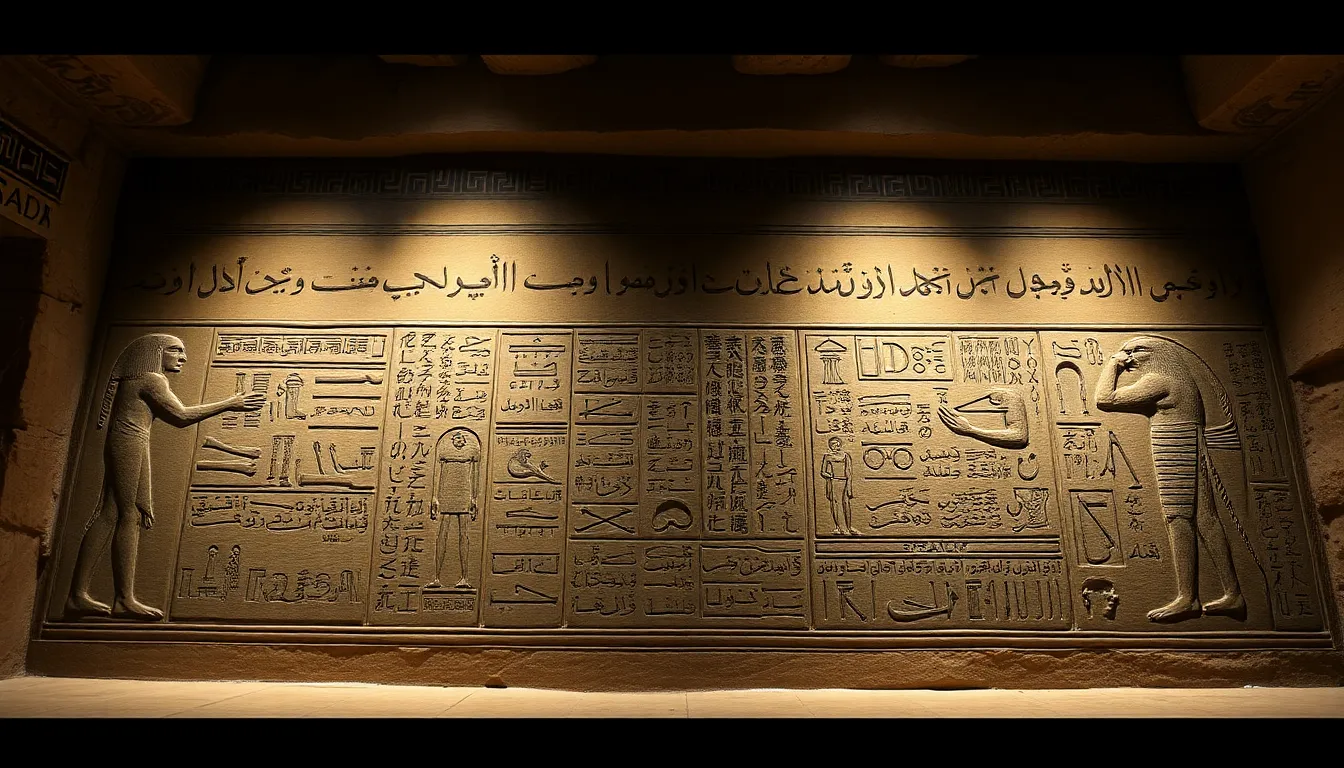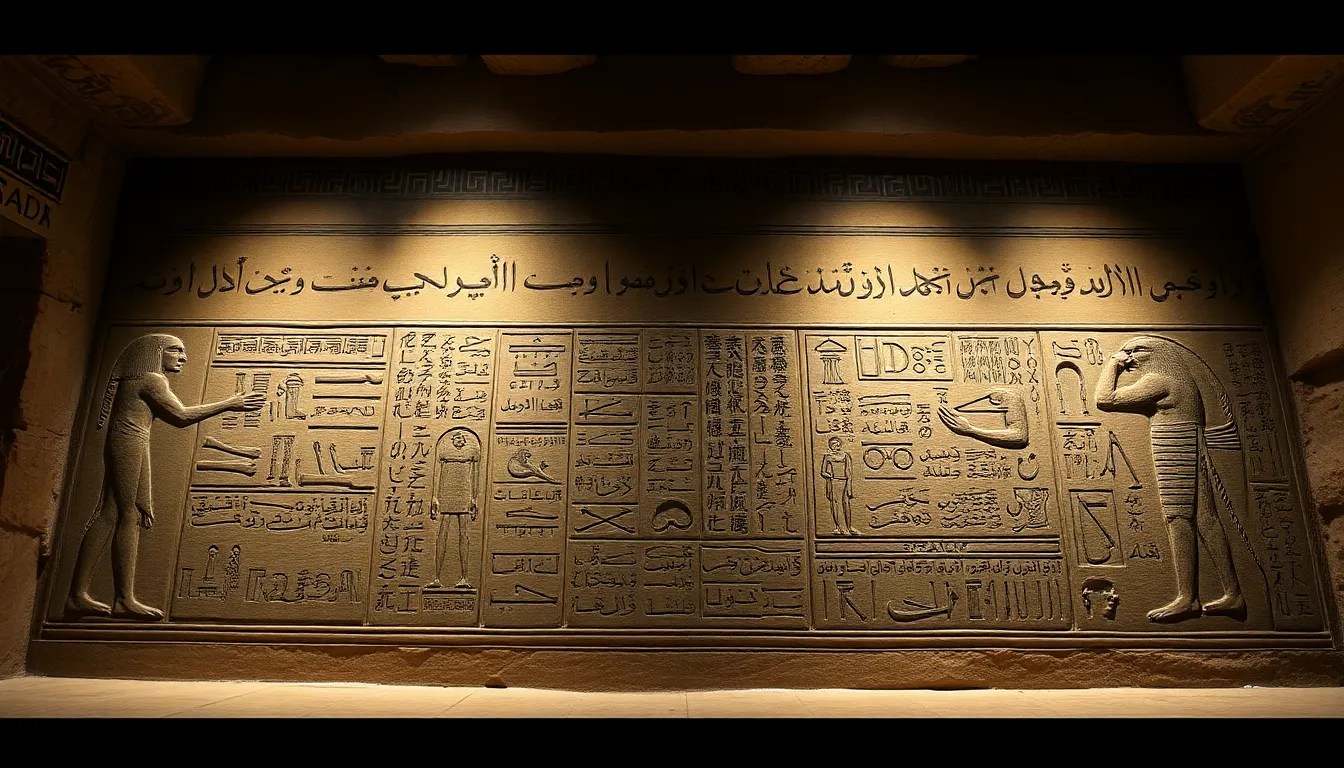The Connection Between Tomb Texts and Ancient Egyptian Art
I. Introduction
Ancient Egypt is renowned for its rich tapestry of beliefs, customs, and artistic achievements, particularly in the context of funerary practices. Among the most significant elements of this ancient culture are tomb texts, which served as essential components in the burial process. These inscriptions, found in various forms such as the Pyramid Texts, Coffin Texts, and the Book of the Dead, provided guidance for the deceased in the afterlife.
Art played a crucial role in these funerary practices, not only as decorative elements but also as a means of expressing beliefs about life, death, and the afterlife. This article explores the intricate relationship between tomb texts and art, demonstrating how they interrelate to reflect Ancient Egyptian cosmology, societal values, and the beliefs surrounding the afterlife.
II. Historical Context of Tomb Texts
A. Definition and Purpose of Tomb Texts
Tomb texts are inscriptions found in the burial chambers of ancient Egyptians, serving various purposes:
- Pyramid Texts: The oldest religious texts in the world, designed for the pharaohs’ tombs, focusing on the king’s journey to the afterlife.
- Coffin Texts: Evolved from Pyramid Texts, these inscriptions were used in the Middle Kingdom and were available to non-royals, emphasizing personal protection in the afterlife.
- Book of the Dead: A compilation of spells and prayers that guided the deceased through the underworld, promoting a safe passage and resurrection.
B. Evolution of Tomb Texts from the Old Kingdom to the Late Period
The development of tomb texts reflects the changing beliefs and practices in Ancient Egypt:
- Old Kingdom: Focused on royal power and the divine nature of the pharaoh.
- Middle Kingdom: More personal and accessible texts, indicating a shift towards individual spirituality.
- New Kingdom and Late Period: A rich amalgamation of previous texts, highlighting themes of judgment and resurrection.
C. Cultural Significance of Burial Practices in Ancient Egypt
The burial practices in Ancient Egypt were deeply intertwined with their cosmology. The elaborate tombs, filled with texts and artifacts, were designed to ensure the deceased’s safe passage to the afterlife. This reflected societal values of honoring the dead and maintaining a connection with the divine.
III. The Function of Art in Tombs
A. Types of Art Found in Tombs
The art within tombs varied widely, encompassing:
- Reliefs: Carvings that depicted daily life and religious rituals.
- Paintings: Colorful depictions of deities, the afterlife, and symbolic scenes.
- Sculptures: Statues that served as vessels for the deceased’s spirit.
B. Symbolism in Tomb Art and Its Relationship to the Afterlife
Art in tombs was rich with symbolism, often used to convey messages about the afterlife. Common themes included:
- The presence of deities who guided the deceased.
- Imagery of resurrection and eternal life.
- Symbolic representations of the journey through the underworld.
C. How Art Served as a Means of Communication with the Divine
Art was not merely ornamental; it was a critical medium of communication. Through intricate designs and depictions of rituals, art facilitated a dialogue between the living and the divine, ensuring that the deceased could navigate the afterlife successfully.
IV. Interplay Between Tomb Texts and Art
A. Visual Representation of Texts within Tomb Art
The interplay between tomb texts and art is evident in how texts are visually represented in artwork. For example, inscriptions are often depicted alongside scenes that illustrate the narrative of the afterlife, enhancing their meaning and impact.
B. Examples of Specific Tombs Where Texts and Art Complement Each Other
Several tombs exemplify this relationship:
- The Tomb of Tutankhamun: Features numerous inscriptions that complement the rich frescoes and artifacts found within.
- The Tomb of Seti I: Showcases intricate wall paintings that narrate the journey of the king through the afterlife alongside detailed texts.
- The Tomb of Nefertari: Illustrates vibrant depictions of the afterlife, paired with texts that echo themes of love and resurrection.
C. The Role of Iconography in Enhancing the Narrative of the Tomb Texts
Iconography in tomb art plays a vital role in enhancing the narratives presented in tomb texts. Symbolic images, such as the Ankh (the symbol of life) and the scarab (representing rebirth), reinforce themes of immortality and the journey beyond death.
V. Case Studies: Notable Tombs and Their Texts
A. The Tomb of Tutankhamun: Art and Inscriptions
The Tomb of Tutankhamun is a treasure trove of art and inscriptions. The walls are adorned with scenes of the young pharaoh’s journey to the afterlife, complemented by texts that provide spells for protection and guidance.
B. The Tomb of Seti I: A Masterpiece of Art and Its Textual Elements
Seti I’s tomb is often hailed as one of the most beautifully decorated tombs in Egypt. The detailed reliefs and vibrant colors are matched with texts that describe the king’s divine lineage and his journey to the afterlife.
C. The Tomb of Nefertari: An Exploration of Themes in Text and Artistry
Nefertari’s tomb exemplifies the harmony between text and art, with stunning wall paintings depicting her in the presence of deities, alongside inscriptions that speak of her beauty and eternal life.
VI. Thematic Connections: Life, Death, and the Afterlife
A. Shared Themes Between Tomb Texts and Artistic Representations
Both tomb texts and art share several themes, including:
- The continuity of life after death.
- The importance of judgment and moral integrity.
- The role of deities in guiding the deceased.
B. The Depiction of Deities, Judgment, and Resurrection in Both Forms
The portrayal of deities, the weighing of the heart, and resurrection scenes are prevalent in both texts and art, illustrating the Egyptians’ beliefs about the afterlife and moral accountability.
C. How These Themes Convey Societal Beliefs About Immortality
These interconnected themes reveal a society deeply concerned with the afterlife and the preservation of the soul, showcasing a belief in immortality that transcended earthly existence.
VII. Modern Interpretations and Legacy
A. Archaeological Discoveries and Their Impact on Understanding Tomb Texts and Art
Recent archaeological discoveries have shed light on the significance of tomb texts and art, enhancing our understanding of Ancient Egyptian beliefs and societal structures.
B. The Influence of Ancient Egyptian Art and Texts on Contemporary Culture
The legacy of Ancient Egyptian art and texts continues to influence modern culture, inspiring various forms of art, literature, and film, all reflecting the fascination with this ancient civilization.
C. Ongoing Research and Its Importance in Egyptology
Ongoing research in Egyptology is crucial for uncovering new insights into the connection between tomb texts and art, allowing us to appreciate the complexity of Ancient Egyptian civilization further.
VIII. Conclusion
The relationship between tomb texts and art in Ancient Egypt is a profound reflection of their beliefs about life, death, and the afterlife. Together, they provide invaluable insights into the values and cosmology of this remarkable civilization. Understanding this connection not only enriches our knowledge of Ancient Egypt but also highlights the enduring legacy of their artistic and textual traditions in our modern world.




